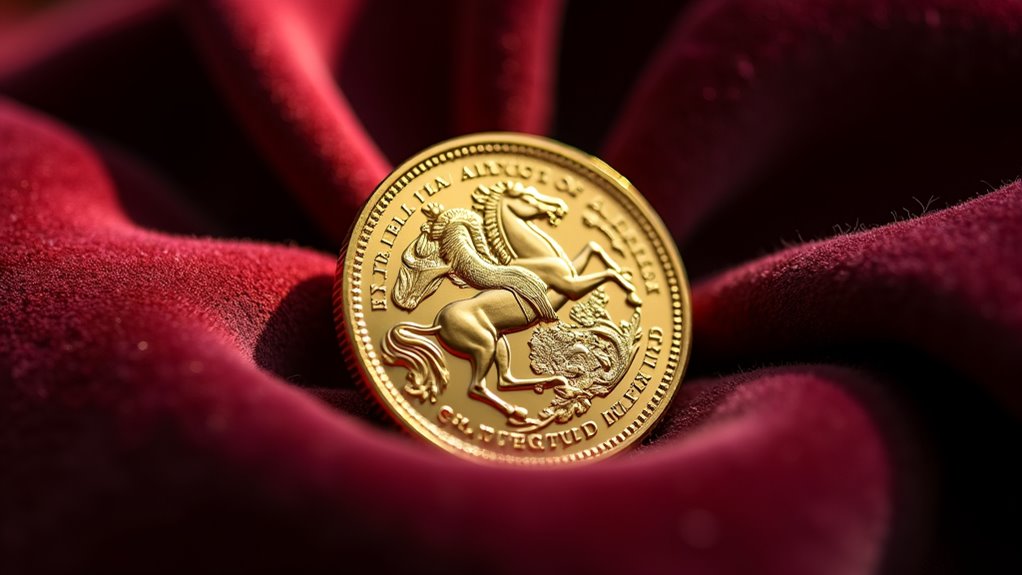The condition and rarity of gold coins dramatically influence their market value beyond mere gold content. Professional grading services like NGC and PCGS evaluate specimens, with pristine examples fetching significant premiums. Limited mintage pieces, such as the 1904 Lewis and Clark $1 coin, command higher prices due to their scarcity. While bullion investors focus on metal content, numismatic enthusiasts prize historical significance and preservation. Understanding these factors reveals the fascinating complexity of gold coin valuation.

Gold Coin Values
The intricate domain of gold coin values rests upon several foundational pillars that determine their worth in today’s market. While the basic melt value of a gold coin is determined by its weight and purity, two essential factors – condition and rarity – often elevate certain pieces far beyond their intrinsic worth, creating a fascinating interplay between collectibility and raw material value.
The condition of a gold coin serves as a primary determinant of its market value, with pristine specimens commanding significant premiums over their worn counterparts. Industry-recognised grading authorities such as NGC and PCGS provide standardised assessments that help establish a coin’s worth. For instance, a 1967 South Africa Gold Krugerrand graded MS-65 might fetch substantially more than an identical piece showing visible wear or damage. Proper storage and careful handling remain essential practises for maintaining a coin’s condition, directly impacting its long-term value appreciation potential. Coin preservation techniques also play a vital role in ensuring that coins retain their market appeal.
Pristine gold coins command premium prices, with expert grading systems providing crucial benchmarks for determining authentic market value.
Rarity introduces another important dimension to gold coin valuation, often overshadowing the basic gold content in determining market prices. Limited mintage pieces, such as the 1904 Gold Lewis and Clark $1 coin, exemplify how scarcity can drive values well above the mere gold weight calculation. Similarly, the 2023 Royal Canadian Mint His Majesty King Charles III’s Royal Cypher demonstrates how contemporary limited editions can generate immediate collector premiums based on their restricted availability.
The numismatic marketplace particularly values the convergence of exceptional condition and genuine rarity. When these qualities combine in a single specimen, the result can be extraordinary price realisation at auction. Certified coins that possess both attributes often attract serious collectors willing to pay substantial premiums above the standard bullion value. This phenomenon is particularly evident in commemorative issues that celebrate significant historical events or feature unique cultural designs.
Market dynamics continually evolve, influenced by collector preferences and broader economic conditions. During periods of economic uncertainty, many investors gravitate towards investment-grade gold coins, while others seek out rare specimens as a means of portfolio diversification. The seasonal nature of collecting can also impact values, with certain pieces experiencing increased demand during specific times of the year.
Professional grading services play a crucial role in this ecosystem, ensuring that collectors are aware of the value impact of a coin’s condition on its market price.
Understanding the delicate balance between condition and rarity helps collectors and investors make informed decisions in the gold coin market. While bullion investors might focus primarily on gold content and weight, numismatic enthusiasts often find greater value in pieces that combine historical significance with exceptional preservation.
This complex interplay of factors continues to shape the market, creating opportunities for both investment and collecting pursuits within the fascinating domain of gold coinage.
Frequently Asked Questions
How Can I Safely Clean My Gold Coins Without Damaging Them?
Gold coins should be cleaned with extreme caution, as improper cleaning can diminish their value.
Safe methods include using mild soap with warm water and a soft microfibre cloth, or dabbing with olive oil to remove surface grime. For stubborn marks, a gentle baking soda paste might help.
It’s essential to avoid harsh chemicals or abrasive materials. When in doubt about a coin’s historical significance, consulting an expert is advisable before attempting any cleaning.
Are Gold Coins a Better Investment Than Gold Bars or Bullion?
The choice between gold coins and bars depends entirely on individual investment goals.
Coins offer greater liquidity and divisibility, making them easier to sell in smaller amounts. They may also carry numismatic value that appreciates over time.
However, gold bars typically have lower premiums and are more cost-effective for large investments. Bars are also more efficient to store, though they’re less liquid.
Neither option is inherently ‘better’ – it’s about matching the investment to personal objectives.
Which Gold Coin Certification Companies Are the Most Trusted and Reputable?
PCGS and NGC stand as the most trusted certification companies in the gold coin industry, with decades of proven reliability and consistent grading standards.
These companies dominate the market due to their rigorous authentication processes and tamper-proof holders.
While ANACS and ICG maintain respectable reputations, particularly for specific niches, they don’t command the same market premiums or global recognition as PCGS and NGC-certified coins.
How Can I Protect My Gold Coins From Environmental Damage?
To protect gold coins from environmental damage, collectors should store them in individual protective capsules and maintain a controlled environment.
A cool, dry location away from direct sunlight is essential, while avoiding areas prone to humidity like basements.
Using cotton gloves when handling coins prevents oils and fingerprints from damaging surfaces.
Regular monitoring with silica gel packets helps control moisture, and storing coins in a home safe or safe deposit box provides additional protection.
What Insurance Options Are Available for Valuable Gold Coin Collections?
Collectors can protect valuable gold coins through specialised insurance options.
Extensive policies offer agreed value coverage, ensuring full collector value protection against theft, damage, and transit risks.
Blanket coverage simplifies insuring entire collections under preset amounts, while specific transit and storage protection covers coins during transport or professional storage.
Regular professional appraisals and detailed record-keeping are essential for maintaining accurate coverage and resolving potential claims.














